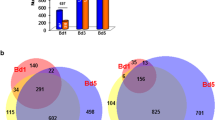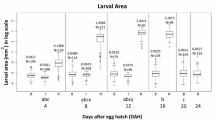Abstract
Through gene-for-gene interactions, wheat plants respond to specific biotypes of Hessian fly upon the initiation of first-instar larval feeding. Leaves of plants containing the H9 resistance gene responded to avirulent biotype L larvae with rapid changes in the levels of several mRNA transcripts and initiation of an incompatible interaction. A low-copy gene, Hfr-1 (Hessian fly-response gene 1), responded with increased mRNA levels for two days before returning to preinfestation levels by day five. Hfr-1 mRNA was constitutively expressed in uninfested control plants as well as in plants infested with virulent larvae. The cDNA sequence was similar to a maize gene encoding a β-glucosidase aggregating factor (BGAF), to jacalin-like mannose-binding lectins, and to several plant genes that respond to microbial infections. The potential roles of Hfr-1 in defending wheat against Hessian fly damage are discussed.
Similar content being viewed by others
REFERENCES
Bent, A. F.1996. Plant disease resistance genes: Function meets structure. Plant Cell8:1757–1771.
Blanchard, D. J., Cicek, M., Chen, J., and Esen, A.2001. Identification of β-glucosidase aggregating factor (BGAF) and mapping of BGAF binding regions on maize β-glucosidase. J. Biol. Chem.276:11895–11901.
Bourne, Y., Zamboni, V., Barre, A., Peumans, W. J., Van Damme, E. J. M., and Rouge, P.1999. Helianthus tuberosuslectin reveals a widespread scaffold for mannose-binding lectins. Structure7:1473–1482.
Brzobohaty, B., Moore, I., Kristoffersen, P., Bako, L., Camos, N., Schell, J., and Palme, K.1993. Release of active cytokinin by a β-glucosidase localized to the maize root meristem. Science262:1051–1054.
Byers, R. A. and Gallun, R. L.1972. Ability of the Hessian fly to stunt winter wheat: Effect of larval feeding on elongation of leaves. J. Econ. Entomol.65:955–958.
Cartwright, W. B. and LaHue, D. W.1944. Testing wheats in the greenhouse for Hessian fly resistance. J. Econ. Entomol.37:385–387.
Cartwright, W. B., Caldwell, R. M., and Compton, L. E.1959. Responses of resistant and susceptible wheats to Hessian fly attack. Agron. J.51:529–531.
Chaudhry, B., Muller-Uri, F., Cameron-Mills, V., Gough, S., Simpson, D., Skriver, K., and Mundy, J.1994. The barley 60 kDa jasmonate-induced protein (JIP60) is a novel ribosomeinactivating protein. Plant J.6:815–824.
Delibes, A., Delmoral, J., Martinsanchez, J. A., Mejias, A., Gallego, M., Casado, D., Sin, E., and Lopezbrana, I.1997. Hessian fly-resistance gene transferred from chromosome 4M (V) of Aegilops ventricosato Triticum aestivum. Theor. Appl. Genet.94:858–864.
Farmer, E. E. and Ryan, C. A.1992. Octadecanoid precursors of jasmonic acid activate the synthesis of wound-inducible proteinase inhibitors. Plant Cell4:129–134.
Foissac, X., Loc, N. T. P. C., Gatehouse, A.M. R., and Gatehouse, J. A.2000. Resistance to green leafhopper (Nephotettix virescens) and brown planthopper (Nilaparvata lugens) in transgenic rice expressing snowdrop lectin (Galanthus nivalisagglutinin; GNA). J. Insect Physiol.46:573–583.
Gallun, R. L.1978. Genetics of biotypes B and C of the Hessian fly. Ann. Entomol. Soc. Am.71:481–486.
Gianoli, E. and Niemeyer, H.M.1998. DIBOA in wild Poaceae: Sources of resistance to the Russian wheat aphid (Diurahis noxia) and the greenbug (Schizaphis graminum). Euphytica102:317–321.
Gorlach, J., Volrath, S., Knauf-Beiter, G., Hengy, G., Beckhove, U., Kogel, K., Oostendorp, M., Staub, T., Ward, E., Kessmann, H., and Ryals, J.1996. Benzothiadiazole, a novel class of inducers of systemic acquired resistance, activates gene expression and disease resistance in wheat. Plant Cell8:629–643.
Green, T. R. and Ryan, C. A.1982. Wound-induced proteinase inhibitors in plant leaves: A possible defense mechanism against insects. Science175:776–777.
Grover, P. B., JR. 1995. Hypersensitive response of wheat to the Hessian fly. Entomol. Exp. Appl.74:283–294.
Grover, P. B., Jr., Ross, D. R., and Shukle, R. H.1988. Identification and partial characterization of digestive carbohydrases in larvae of the Hessian fly, Mayetiola destructor(Say) (Diptera: Cecidomyiidae). Arch. Insect Biochem. Physiol.5:59–72.
Grover, P. B., Jr., Shukle, R. H., and Foster, J. E.1989. Interactions of Hessian fly (Diptera: Cecidomyiidae) biotypes on resistant wheat. Environ. Entomol.18:687–690.
Habibi, J., Backus, E. A., Coudron, T. A., and Brandt, S. L.2001. Effect of different host substances on hemipteran salivary protein profiles. Entomol. Exp. Appl.98:369–375.
Hatchett, J. H. and Gallun, R. L.1970. Genetics of the ability of the Hessian fly, Mayetiola destructor, to survive on wheats having different genes for resistance. Ann. Entomol. Soc. Am.63:1400–1407.
Hahn, M., Jungling, S., and Knogge, W.1993. Cultivar-specific elicitation of barley defense reactions by the phytotoxic peptide NIP1 from Rhynchosporium secalis. Mol. Plant–Microbe Interact.6:745–754.
Korth, K. L. and Dixon, R. A.1997. Evidence for chewing insect-specific molecular events distinct from a general wound response in leaves. Plant Physiol.115:1299–1305.
Lee, J., Parthier, B., and Lobler, M.1996. Jasmonate signaling can be uncoupled from abscisic acid signaling in barley: Identification of jasmonate-regulated transcripts which are not induced by abscisic acid. Planta199:625–632.
Liang, P. and Pardee, A. B.1992. Differential display of eukaryotic messenger RNA by means of the polymerase chain reaction. Science257:967–971.
Lin, K.-C., Bushnell, W. R., Szabo, L. J., and Smith, A. G.1996. Isolation and expression of a host response gene family encoding thaumatin-like proteins in incompatible oat-stem rust fungus interactions. Mol. Plant–Microbe Interact.9:511–522.
Maas, F. B., III., Patterson, F. L., Foster, J. E., and Ohm, H. W.1989. Expression and inheritance of resistance of ELS 6404-160 durum wheat to Hessian fly. Crop Sci.29:23–28.
Maniatis, T., Fritsch, E. F., and Sambrook, J.1982. Molecular Cloning: A Laboratory Manual. Cold Spring Harbor Laboratory, Cold Spring Harbor, New York.
Mattiacci, L., Dicke, M., and Posthumus, M. A.1995. β-glucosidase: An elicitor of herbivoreinduced plant odor that attracts host-searching parasitic wraps. Proc. Natl. Acad. Sci. USA92:2036–2040.
Miles, P. W.1999. Aphid saliva. Biol. Rev.74:41–85.
Molina, A., Gorlach, J., Volrath, S., and Ryals, J.1999. Wheat genes encoding two types of PR-1 proteins are pathogen inducible, but do not respond to activators of systemic acquired resistance. Mol. Plant–Microbe Interact.12:53–58.
Moran, P. J. and Thomson, G. A.2001. Molecular responses to aphid feeding in Arabidopsisin relation to plant defense pathways. Plant Physiol.125:1074–1085.
Morris, S.W., Vernooij, B., Titatarn, S., Starrett, M., Thomas, S., Wiltse, C. C., Frederiksen, R. A., Bhandhufalck, A., Hulbert, S., and Uknes, S.1998. Induced resistance responses in maize. Mol. Plant-Microbe Interact.11:643–658.
Mouradov, A., Mouradova, E., and Scott, K. J.1994. Gene family encoding basic pathogenesisrelated 1 proteins in barley. Plant Mol. Biol.26:503–507.
Niemeyer, H. M. and Jerez, J. M.1997. Chromosomal location of genes for hydroxamic acid accumulation in Triticum aestivumL. (wheat) using wheat aneuploids and wheat substitution lines. Heredity79:10–14.
Osborn, T. C., Alexander, D. C., and Fobes, J. F.1987. Identification of restriction fragment length polymorphisms linked to genes controlling soluble solids content in tomato fruit. Theor. Appl. Genet.73:350–356.
Painter, R. H.1930. The biological strains of Hessian fly. J. Econ. Entomol.23:322–326.
Patterson, F. L., Maas III, F. B., Foster, J. E., Ratcliffe, R. R., Cambron, S., Safranski, G., Taylor, P. L., and Ohm, H. W.1994. Registration of eight Hessian fly resistant common winter wheat germplasm lines (Carol, Erin, Flynn, Iris, Joy, Karen, Lola, and Molly). Crop Sci.34:315–316.
Pautot, V., Holzer, F. M., Reisch, B., and Walling, L. L.1993. Leucine aminopeptidase: An inducible component of the defense response in Lycopersicon esculentum(tomato). Proc. Natl. Acad. Sci. USA90:9906–9910.
Peumans, W. J., Barre, A., Hao, Q., Rouge, P., and Van Damme, E. M. J.2000. Higher plants developed structurally different motifs to recognize foreign glycans. Trends Glycosci. Glycotech.12:83–101.
Ratcliffe, R. H. and Hatchett, J. H.1997. Biology and genetics of the Hessian fly and resistance in wheat. pp. 47–56 inK. Bonardi (ed.). New Developments in Entomology. Research Signpost, Trivandrum, India.
Rebmann, G., Mauch, F., and Dudler, R.1991. Sequence of a wheat cDNA encoding a pathogeninduced thaumatin-like protein. Plant Mol. Biol.17:283–285.
Refai, F. Y., Jones, E. T., and Miller, B. S.1955. Some biochemical factors involved in the resistance of the wheat plant to attack by the Hessian fly. Cereal Chem.32:437–442.
Robinson, R. J., Miller, B. S., Miller, H. L., Mussman, H. C., Johnson, J. A., and Jones, E. T.1960. Chloroplast number in leaves of normal wheat plants and those infested with Hessian fly or treated with maleic hydrazide. J. Econ. Entomol.53:560–566.
Schaffrath, U., Freydl, E., and Dudler, R.1997. Evidence for different signaling pathways activated by inducers of acquired resistance in wheat. Mol. Plant-Microbe Interact.10:779–783.
Sembdner, G. and Parthier, B.1993. The biochemistry and the physiological and molecular actions of jasmonates. Annu. Rev. Plant. Physiol. Plant. Mol. Biol.44:569–589.
Shukle, R. H., Grover, P. B., Jr., and Mocelin, G.1992. Responses of susceptible and resistant wheat associated with Hessian fly (Diptera: Cecidomyiidae) infestation. Environ. Entomol.21:845–853.
Stout, M. J., Workman, K. V., Workman, J. S., and Duffey, S. S.1996. Temporal and ontogenic aspects of protein induction in foliage of the tomato, Lycopersicon esculentum. Biochem. Syst. Ecol.24:611–625.
Van de Ven, W. T. G., LeVesque, C. S., Perring, T. M., and Walling, L. L.2000. Local and systemic changes in squash gene expression in response to silverleaf whitefly feeding. Plant Cell12:1409–1423.
Van der Westhuizen, A. J. and Pretorius, Z.1998. Protein composition of wheat apoplastic fluid and resistance to the Russian wheat aphid. Aust. J. Plant Physiol.23:645–648.
Van der Westhuizen, A. J., Qian, X.-M., and Botha, A.-M.1998. β-Glucanases in wheat and resistance to Russian wheat aphid. Physiol. Plant. 103:125–131.
Walling, L. L.2000. The myriad plant responses to herbivores. J. Plant Growth Regul.19:195–216.
Wallner, S. J. and Walker, J. E.1975. Glycosidases in cell wall-degrading extracts of ripening tomato fruits. Plant Physiol.55:94–98.
Wellso, S. G., Hoxie, R. P., and Olien, C. R.1989. Effects of Hessian fly (Diptera: Cecidomyiidae) larvae and plant age on growth and soluble carbohydrates of “Winoka” winter wheat. Environ. Entomol.18:1095–1100.
Wellso, S. G., Hoxie, R. P., and Taylor, P. L.1990. A comparison of plant parameters and soluble carbohydrates of resistant and susceptible wheat infested with biotype E Hessian flies (Diptera: Cecidomyiidae. Environ. Entomol.19:1698–1701.
Zhang, W., Peumans, W. J., Barre, A., Astoul, C. H., Roviera, P., Rouge, P., Proost, P., TruffaBachi, P., Jalali, A. A. H., and Van Damme, E. J. M.2000. Isolation and characterization of a jacalin-related mannose-binding lectin from salt-stressed rice (Oryza sativa) plants. Planta210:970–978.
Author information
Authors and Affiliations
Corresponding author
Rights and permissions
About this article
Cite this article
Williams, C.E., Collier, C.C., Nemacheck, J.A. et al. A Lectin-Like Wheat Gene Responds Systemically to Attempted Feeding by Avirulent First-Instar Hessian Fly Larvae. J Chem Ecol 28, 1411–1428 (2002). https://doi.org/10.1023/A:1016200619766
Issue Date:
DOI: https://doi.org/10.1023/A:1016200619766




